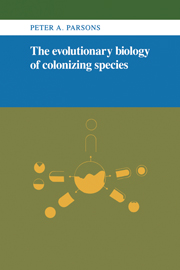Book contents
- Frontmatter
- Contents
- Preface
- 1 Introduction: Colonists and habitats
- 2 Genetics and ecology
- 3 Physical conditions, resources, and ecological phenotypes
- 4 Variability in natural populations
- 5 Genetic variability, ecological phenotypes, and stressful environments
- 6 Colonizing phenotypes and genotypes
- 7 Behavioral variability in natural populations
- 8 Habitat selection
- 9 The ecobehavioral phenotype: generalists and specialists
- 10 The ecobehavioral phenotype: biological control and domestication
- 11 Parasites and plants
- 12 Discussion and conclusions
- Appendix The study of quantitative traits
- References
- Index
3 - Physical conditions, resources, and ecological phenotypes
Published online by Cambridge University Press: 15 September 2009
- Frontmatter
- Contents
- Preface
- 1 Introduction: Colonists and habitats
- 2 Genetics and ecology
- 3 Physical conditions, resources, and ecological phenotypes
- 4 Variability in natural populations
- 5 Genetic variability, ecological phenotypes, and stressful environments
- 6 Colonizing phenotypes and genotypes
- 7 Behavioral variability in natural populations
- 8 Habitat selection
- 9 The ecobehavioral phenotype: generalists and specialists
- 10 The ecobehavioral phenotype: biological control and domestication
- 11 Parasites and plants
- 12 Discussion and conclusions
- Appendix The study of quantitative traits
- References
- Index
Summary
Climate plays an important role in determining the average numbers of a species, and periodical seasons of extreme cold or drought seem to be the most effective of all checks.
[Darwin, 1859, Chap. III]Waddington: Has anyone done experiments to try to determine the temperature tolerances or range of foods which these things will accept? Taking your widespread species, have they got a wider temperature tolerance or do they get slowed up less by lower temperature etc.?
[Discussion at end of Dobzhansky (1965:549), who was writing on Drosophila species.]Hard (and soft) selection
The physical conditions tolerated and the resources utilized by organisms play a vital role in determining their distribution and abundance. Collectively, these traits can be called ecological phenotypes, implying a relationship with the r–K continuum. Extremes of physical conditions cause death after various periods of time irrespective of the density or the frequency of organisms, that is, populations are subject to hard selection in the sense of Wallace (1981).
The difference between hard and soft selection is well illustrated using an example presented by Wallace (1981) on two methods whereby a plant breeder can obtain seed while carrying out a program of artificial selection for increased yield. The breeder plants his experimental seed in a randomized series of test plots (Figure 3.1). At maturity, there are two procedures whereby selected heads may be chosen, which arise because of variation of soil conditions, other environmental variations among plots, or genotype differences.
- Type
- Chapter
- Information
- The Evolutionary Biology of Colonizing Species , pp. 20 - 42Publisher: Cambridge University PressPrint publication year: 1983



